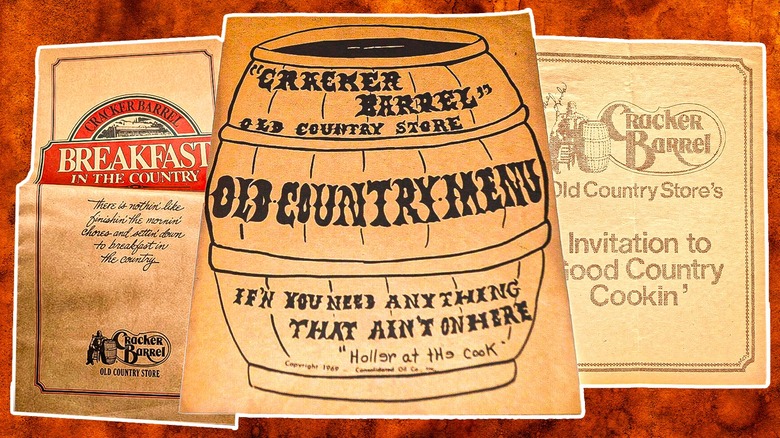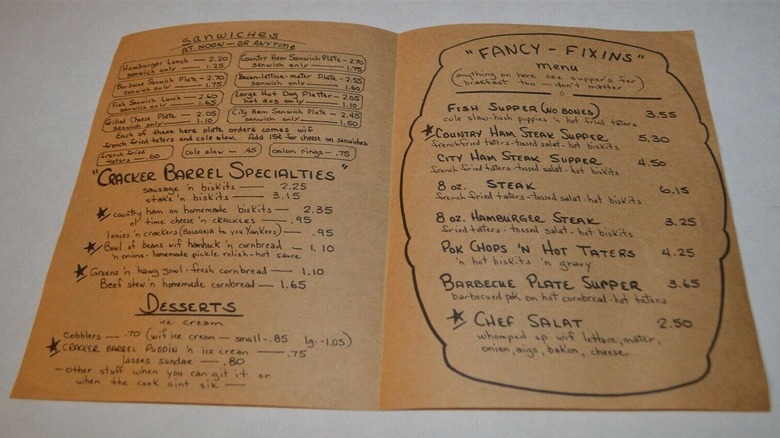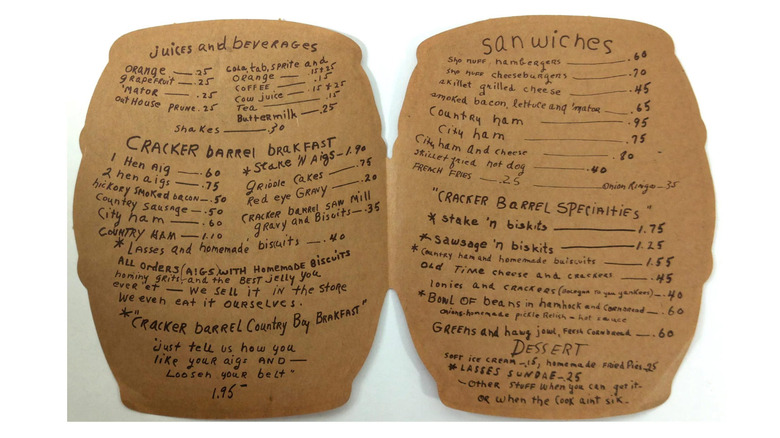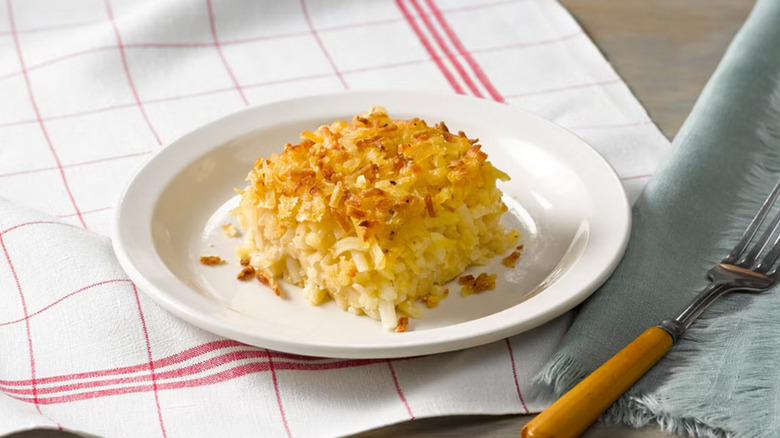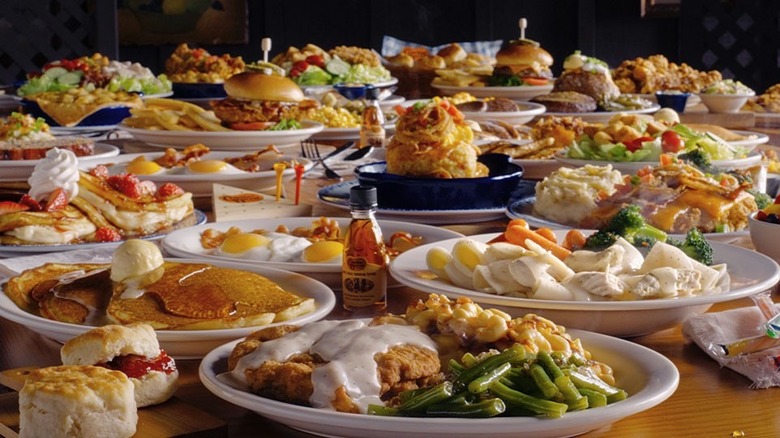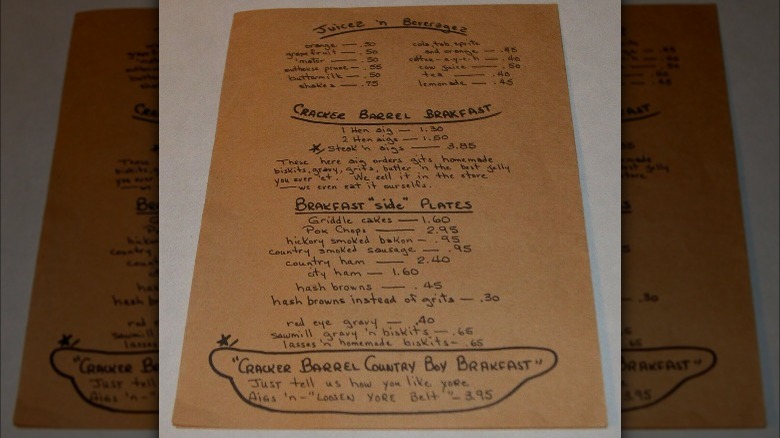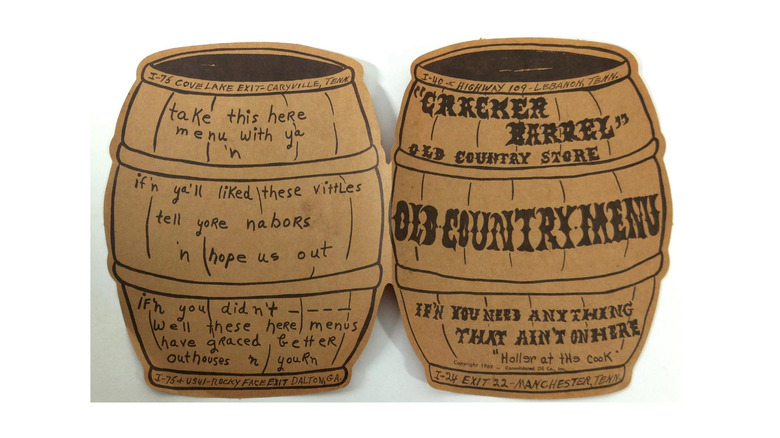Here's How Cracker Barrel's Menu Has Changed Since 1969
It's clear that Cracker Barrel has come a long way from opening its first country store in Lebanon, Tennessee, to launching trendy ghost kitchens in Hollywood, California — but how much has its menu actually changed? A great deal as it turns out.
For starters, the actual copyright on the 1969 menu is not connected to Cracker Barrel as a brand; it's copyrighted to Consolidated Oil Co., Inc. The reason it's a restaurant that's well-known as a road trip staple is that the original locations were a combination of a restaurant with a country store and a Shell gas station. This new venture was founder David Evins' play to create a successful restaurant business while gassing up his family's oil business at the same time. Each Cracker Barrel was conveniently placed near a highway offramp to funnel cars to Evins' fuel pumps with the allure of a homecooked meal alternative to fast food.
It worked for a while, but the 1970s oil embargo against the United States forced Evins to abandon the gas station half and focus solely on serving proper country food. By the '80s, Evins had greatly expanded the menu and it was copyrighted to Cracker Barrel Old Country Store. Things just kept evolving and these are the biggest changes you'll find.
Menus are no longer handwritten
While there were most certainly printer services available, Dan Evins insisted on handwritten menus and is said to have written the first one himself. He wanted everything to look as rustic as possible to lean into his branding as a homey southern eatery where the food was made from scratch just like the menus, which were written in black marker. Evins went a step further in his plan to keep things unsophisticated by using the same type of brown paper as a grocery bag. The idea was for the menus to look like what your country store items would be bagged in.
By 1985, Cracker Barrel was using a professional printer but kept the brown craft paper. It might not be handwritten but the chain stuck to its homey style in other ways. The cover was designed to look like a cross-stitch pattern and that year's menu included funny country rhymes in the margins like "Chicken in the bread basket, peckin' out dough. Granny, does your dog bite? No, chile, no." These days, Cracker Barrel has gone more mainstream in its menu style and the 2023 version doesn't stand out from any other menu you'll come across.
The drink selection has received a serious makeover
Cracker Barrel went from offering 13 options in 1969 to currently having over 50 items on its drink menu. The earliest version kept it simple with a range of juices, coffee, milk, buttermilk, shakes, and a choice of four different sodas: cola, Tab, Sprite, and orange. There's a lot of room for growth and it sure did grow.
The soda menu has more than doubled in size and it's mainly made up of retro flavors in glass bottles like butterscotch beer soda, Ale-8-One, and root beer. Ironically, Cracker Barrel didn't offer those flavors during retro times.
The original location didn't serve alcohol and the modern addition of beers, wine, and three flavors of fruity mimosas makes up a large proportion of the expansion. Its coffee menu has also been broadened to include hot and iced lattes in plain, mocha, vanilla, and caramel.
Despite greatly lengthening the drink list, there are some original items that you won't find today. Gone are the days when you could order "outhouse prune" juice or a big ol' glass of buttermilk. Milkshakes were also taken off but you can order one as a secret menu item instead.
You wouldn't find the famous hashbrown casserole in 1969
If you went to your local Cracker Barrel in 1969, you could have had a side of hashbrowns for $0.45 but you couldn't have ordered the iconic hashbrown casserole. That little square of crave-able potatoes mixed with sweet bits of onion and a cheesy cream sauce is such a staple that it's hard to imagine it ever not being there. It's unclear when this item was added, but it can be found on menus as early as 1985.
In 2023, Cracker Barrel surveyed guests and found that its hashbrown casserole was voted the number one side dish. They're such a fan favorite that the restaurant has expanded on them by offering loaded hashbrown casserole (topped with extra cheese and bacon), hashbrown casserole tots (balls of the casserole deep fried), and loaded hashbrown casserole tots (tots with extra cheese and bacon). If there are no locations close to you, you can try your hand at making a Cracker Barrel hashbrown casserole copycat recipe.
It's become significantly bigger
For a little gas station eatery and shop, starting out with offering 58 items was ambitious but it clearly played well with the original patrons. The selection has now nearly tripled in size to around 170 items (depending on your location).
For the most part, the brand stuck with its Southern comfort food theme and simply added more variety. Cracker Barrel still serves a hamburger steak and steak like in 1969, but it's also added country fried steak, meatloaf, and roast beef. The original menu didn't have a single chicken dish and today you'll find over a dozen offerings from classic Southern fried chicken to homey chicken n' dumplings. The restaurant has also added some new items like strawberry cheesecake stuffed pancakes, pancake tacos, and vegetarian Impossible breakfast sausage.
While the menu has increased in size, there are some dishes that you won't find anymore. If you go today, you won't find greens n' hawg jowl, bologna and crackers, or red eye gravy. Even more recent additions have been discontinued like the rosin baked potatoes from the 1985 menu, which were whole potatoes "cooked in a big pot of boilin' pine rosin."
It would have hit your wallet differently
The 1969 menu is a peek into a different time when you could get a one-egg breakfast with biscuits, gravy, and grits for $1.30. However, if you run the numbers, you'll find that when adjusted for inflation, Cracker Barrel is cheaper now than it was back then.
For example, the Country Boy Breakfast has been on the menu from the beginning. It's a "loosen yore belt" type of meal with three eggs, two sides, biscuits and gravy, and a choice of protein like steak or ham. Originally, it cost $3.95 and if you order it today you'll pay $13.39. According to the U.S. Bureau of Statistics, $3.95 in 1969 would have been the equivalent of paying $32.38. Paying almost $4.00 for a meal was more expensive back then than you'd think. Hamburger Steak (another menu item that has survived the test of time) cost $3.25 in 1969, which has the same buying power as $26.62 in today's money. Hamburger Steak is currently less than half that at $10.99. Cracker Barrel was a splurge for folks in 1969 whereas today it's an average dinner out.
Interestingly, the coffee has stayed about the same. In 1969 it was $0.40 and that would have been equal to paying $3.28. You can get a cup of Joe there today for $3.19 but some locations offer free coffee if you ask for it.
The wording has lost its folksy charm
Founder Dan Evins' idea to hammer home the authenticity of down-to-earth southern cooking not only included handwritten menus on brown paper — it also meant spelling items as they were pronounced. This led to menu options like "'mator" instead of tomato in the juice section or steak and biscuits spelled as "stake n' biskits." Some items were so stylized that they came with translations for tourists who weren't from around there. One line on the 1969 menu reads, "lonies n' crackers (BOLOGNA to you Yankees.)"
These written versions were also a little cheeky. The back of another menu copyrighted 1969 reads, "Take this here menu with ya 'n if'n y'all liked these vittles tell yore nabors 'n hope us out. If'n you didn't...well, these here menus have graced better outhouses 'n yourn." Essentially saying, "If you don't like our food, our bathrooms are nicer than your house."
This approach to folksy charm didn't last and by 1985 everything on the menu was spelled as you would expect it. The only hint that prevails is that today's menu keeps the "n'" in dishes like biscuits n' gravy.
